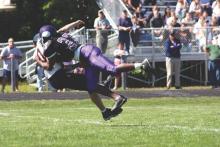High school football athletes have more concussion-related symptoms than either college or youth football athletes, and have the highest proportion of concussions for which athletes are kept from play for at least 30 days, according to injury surveillance data published online May 2 in JAMA Pediatrics.
Researchers analyzed data on 1,429 sports-related concussions, collected by three injury surveillance programs, finding that high school football players with concussions showed the highest mean number of reported symptoms (5.60), followed by college athletes (5.56) and youth (4.76).
“Our findings suggest an association between level of competition and these outcomes, and highlight the need for future research to continue exploring how the epidemiology of sports-related concussion varies across the lifespan,” wrote Zachary Y. Kerr, Ph.D., of the Datalys Center for Sports Injury Research and Prevention, Indianapolis, and his coauthors.
Overall, 15.5% of concussions resulted in the athlete being returned to play after at least 30 days, and 3.1% of athletes with concussion returned to play less than 24 hours after the concussion.
“In youth football, 1 in10 athletes with concussions returned to play less than 24 hours after injury,” the authors reported. “Such findings may be the result of athletes presenting with delayed concussion symptoms, disagreement between athletic trainers and physicians, or difficulty of youth in reporting symptoms.”
The odds of return to play at least 30 days after injury were significantly higher in high school athletes (odd ratio, 2.89) and youth athletes (OR, 2.75), compared with college athletes (JAMA Pediatrics. 2016 May 2. doi: 10.1001/jamapediatrics.2016.0073).
The mean number of concussion symptoms reported was 5.48, with the most common symptoms being headache (94.3%), dizziness (75.0%), and difficulty concentrating (60.5%). The authors noted that very few concussions in any level of play resulted in loss of consciousness, pointing out that this further highlighted the limited utility of that symptom in diagnosis.
Neurocognitive symptoms such as difficulty concentrating and excess drowsiness were more common in high school than in youth athletes, while both high school and college athletes reported a higher mean number of sleep symptoms than did youth athletes.
“These data provide the most common symptoms across levels of play, providing clinicians some guidance as to which symptoms should be minimally included in an assessment,” the authors wrote.
The study was supported by USA Football, the National Athletic Trainers’ Association Research and Education Foundation, BioCrossroads in partnership with the Central Indiana Corporate Partnership Foundation, and the National Collegiate Athletic Association. No financial conflicts of interest were reported.

